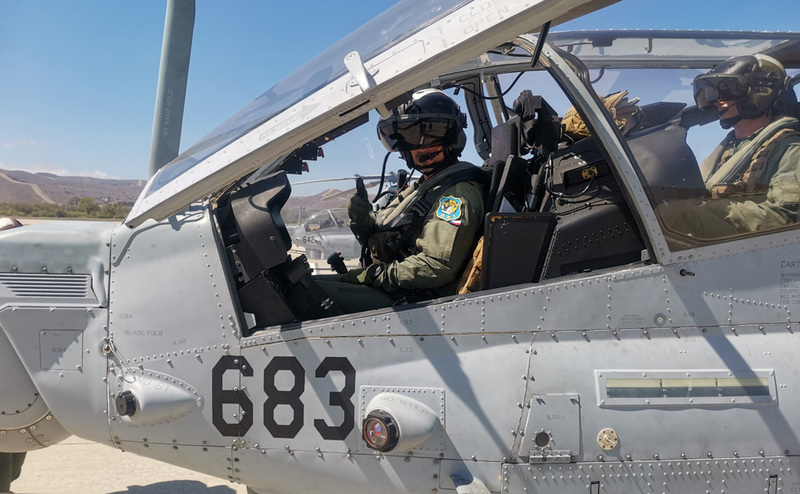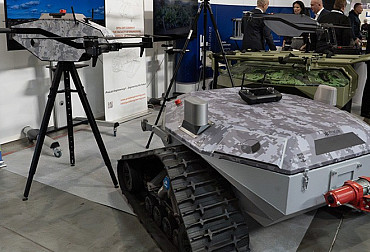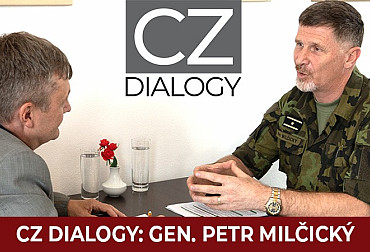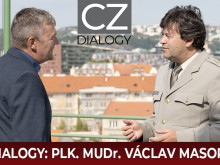Gen. Petr Čepelka: The real capability of the military is not about weapons, it's about people
In the context of the ongoing conflict in Ukraine, there is more and more talk about whether the Czech Army is capable of protecting its airspace on its own. The topic of modernisation of the Czech Air Force is also very often mentioned, namely in the field of ground air defence, unmanned aerial vehicles, transport aircraft, the acquisition of AH-1Z Viper attack helicopters and UH-1Y Venom multi-purpose helicopters. Of course, the possible acquisition of F-35 aircraft is also discussed, which is also related to the issue of building the necessary infrastructure. In the next episode of our discussion programme CZ DIALOGY, we talked about these key topics and not only about them with the Commander of the Czech Air Force, Major General Petr Čepelka
Video: Interview with Commander of the Czech Air Force Major General Petr Čepelka / CZ DEFENCE
"The basic task of the Czech Air Force is to protect the airspace of the Czech Republic. All our activities are based on this. We take available measures to successfully and effectively protect the Czech airspace 24/7. Achievement of these required objectives is carried out by the Air Force in accordance with CAPABILITY CODES AND CAPABILITY STATEMENTS and ACO FORCES STANDARDS. In the sub-areas, the Air Force's capability framework focuses on establishing individual steps, particularly in the area of training both abroad and, in particular, on the territory of the Czech Republic, as well as on the training of key personnel. Within the framework of our legal obligations, it is important that we are able to defend and protect important objects for the Czech Republic (the so-called critical infrastructure) and to reliably provide support to ground and special forces," said General Petr Čepelka.
According to General Čepelka, the Air Force's other capabilities include air transport, both strategic and tactical. In this area, new aircraft must be acquired, whether small transport or medium transport. The current situation in the air force is not simple. The air force, like other types of forces, is undergoing dynamic modernisation. "We are acquiring new equipment, modernising, training and trying to recruit new personnel. The challenges are many. However, the fundamental and the biggest problem that I perceive at the moment is in personnel. We have to take many measures in this area to become an attractive, interesting and promising organisation for young people. In all our activities, well-trained soldiers are important. We are currently conducting an analysis at the General Staff, the results of which will tell us how we should approach personnel, what conditions we should create and how we should mitigate attrition and make the Air Force more attractive," General Čepelka said. If this can be done, he says, the basic problem is solved: "The real capability of the Army is not about weapons, but about people. And if we have well-prepared and motivated personnel, we have half the battle won."
 Picture: In this episode of our discussion show CZ DIALOGY, we talked to the Commander of the Air Force of the Army of the Czech Republic, Major General Petr Čepelka | Michal Pivoňka / CZ DEFENCE
Picture: In this episode of our discussion show CZ DIALOGY, we talked to the Commander of the Air Force of the Army of the Czech Republic, Major General Petr Čepelka | Michal Pivoňka / CZ DEFENCE
In addition to people, airfields are also important to the Air Force. Currently, the Army uses four airfields. The first is in Čáslav, home to the 21st Tactical Air Base. The second airport is near Namesti nad Oslavou, where the 22nd Helicopter Air Base operates. Another airport is in Kbely, where the 24th Transport Air Base is located. Finally, the army uses the airport in Pardubice. When asked whether the army will be interested in other airports in the future, General Čepelka replied, "The army is counting on the airport in Přerov-Bochor, but it is not yet fully defined how it will be used. Our advantage is that we have a relatively extensive network of public and non-public airports in the Czech Republic. And, of course, we are discussing at the General Staff which airports we could use more or less if necessary. So my answer is yes, we are counting on the use of other airports. However, our efforts are now focused on upgrading the existing airport infrastructure at all four current destinations."
And how is the modernisation of the Air Force going? Simply put, the Air Force is currently modernising almost everything. "We have started the modernisation of mobile radars, we have already successfully completed the military trials here and nothing prevents their successful implementation. It is high time we had new MADRs at our disposal," says General Čepelka. Another well-known part of the renewal of the Air Force's equipment is the transition from Russian-made Mi-24/35 helicopters to the H-1 platform (Viper and Venom helicopters), which will mean a significant shift in the increase in capabilities for the helicopter air force. "We are also replenishing the fleet of transport aircraft and will acquire medium transport aircraft. These are the very aircraft whose capacity we lacked, for example, when evacuating citizens from Afghanistan," said the general, who said similar machines would certainly be used, for example, to evacuate people from Sudan or during the earthquake in Turkey. "With this platform and technology, we will be able to provide assistance to the civilian population even in the event of natural disasters, and of course the aircraft will be used for the benefit of the military. And we are also planning to acquire small transport aircraft," General Čepelka added.
 Picture: Photo from the retraining of our pilots in the USA | 22nd Helicopter Air Base
Picture: Photo from the retraining of our pilots in the USA | 22nd Helicopter Air Base
The possible future acquisition of the US F-35 5th generation aircraft is also a major challenge for the army. At this time, the inter-ministerial negotiating team is in intensive talks with the US government. The "Military Recommendation on the Future Shape of Tactical Air Forces after 2035" was essential for the start of negotiations on the acquisition of this aircraft. We wondered why the military recommended the purchase of the F-35? "We did several analyses, but the most important one was done by the JAPCC (Joint Air Power Competence Centre). In preparing the military recommendation, we asked for the opinion of this particular organisation, the Centre of Excellence, which is tasked with supporting individual NATO member countries and discussing with them what the shape of their tactical air forces should look like in relation to the fulfilment of current and future missions. To us, these analyses were essentially the same. We all know very well that fifth-generation aircraft will overwhelmingly operate in the future not only over Europe but also in other areas around the world." explains General Čepelka. "The Army's final recommendation then was to acquire 5th generation aircraft supplemented by drones. The 5th generation aircraft really meets the highest parameters. Its eventual introduction will mean a hit to the concept of air defence, as this multi-role aircraft is becoming an important part of our and the Alliance's Air Defence. In the area of air defence, we would also like to expand the capabilities of the SPYDER sets and join international programmes dealing with the collective protection of the airspace of allied countries," the general plans.
"If the decision to procure the 5th generation aircraft is made, it would truly be a game changer for our entire military. We are not planning to acquire just an aircraft, but an entire capability that will be essential to our success in the future theater of war. This project will also involve the redevelopment of the airbase in Čáslav. In this context, there is talk of considerable investment in the necessary infrastructure. We would like to reach all the standards achieved by neighbouring countries in the construction of immovable infrastructure. It is important that the Čáslav base meets the requirements for the construction of new facilities for the F-35 aircraft. We are not starting from scratch, the base is on its way. We are operating fourth-generation aircraft. The NI extension for fifth-generation aircraft will focus primarily on hangar bays, as well as facilities that will be subject to strict safety rules. We are currently gathering insights from our partners who have experience in building airfield infrastructure specifically for the F-35 aircraft, and not only in the US," the Air Force commander revealed.
We also addressed the question of what is the optimal number of aircraft and other elements within the Air Force to ensure the protection of its own airspace and at the same time the fulfilment of tasks within the Alliance. "We have the forces and means to protect the airspace of the Czech Republic. We also have assets that are dedicated to NATO to act for the benefit of the coalition forces in the event of a crisis. I, as the commander of the air force, would like to see as many aircraft as possible, but we live in an environment where we cannot prioritise one capability over others. So it is important to me that we have two squadrons to cover the commitments that the Czech Republic has. I am convinced that two squadrons will be fully sufficient to reliably meet the commitments we have," the general said.
The Ukrainian conflict has shown that the use of unmanned aerial vehicles can contribute to decisive moments in the battlefield. We wondered whether this is a certain inspiration for our army. According to General Čepelka, drones have done and continue to do a tremendous job in Ukraine. "But we can't just look at Ukraine, we can't just be an army of drones. We are dealing with this issue very intensively. I would certainly like to mention that the Army of the Czech Republic has a lot of experience with their use. During the Czechoslovak army we had VR-3 Rejs, then we used Sojka (Sojka III) for a long time, then we flew thousands of hours with Scan Eagle in Afghanistan and we continue to operate this unmanned vehicle. Our experts have a lot of experience, and when the concept of using unmanned vehicles in our army is completed, we will know how to proceed," General Čepelka said in an interview.
Part of the Czech Air Force is ground-based air defence, which has long suffered from underfunding, when there was an idyllic notion that we were not so threatened from the air. Within the framework of the increase in defence spending of 2% of GDP, according to Gen. Čepelka, among other things, it is expected that air defence resources will be supplemented. This is one of the army's priorities.
During the interview with General Čepelka, we also discussed the training of combat pilots, the experience of pilots and ground personnel with the new Venom and Viper helicopters, the planned acquisitions that the Czech Air Force will make in the future, and other topics.
If you are interested in our full interview with Major General Petr Čepelka, watch the video at the beginning of this article.





















